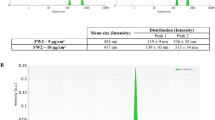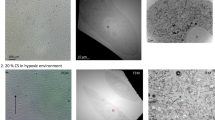Abstract
Wide applications and extreme potential of metal oxide nanoparticles (NPs) increase occupational and public exposure and may yield extraordinary hazards for human health. Exposure to NPs has a risk for dysfunction of the vascular endothelial cells. The objective of this study was to assess the cytotoxicity of six metal oxide NPs to human cardiac microvascular endothelial cells (HCMECs) in vitro. Metal oxide NPs used in this study included zinc oxide (ZnO), iron(III) oxide (Fe2O3), iron(II,III) oxide (Fe3O4), magnesium oxide (MgO), aluminum oxide (Al2O3), and copper(II) oxide (CuO). The cell viability, membrane leakage of lactate dehydrogenase, intracellular reactive oxygen species, permeability of plasma membrane, and expression of inflammatory markers vascular cell adhesion molecule-1, intercellular adhesion molecule-1, macrophage cationic peptide-1, and interleukin-8 in HCMECs were assessed under controlled and exposed conditions (12–24 h and 0.001–100 μg/ml of exposure). The results indicated that Fe2O3, Fe3O4, and Al2O3 NPs did not have significant effects on cytotoxicity, permeability, and inflammation response in HCMECs at any of the concentrations tested. ZnO, CuO, and MgO NPs produced the cytotoxicity at the concentration-dependent and time-dependent manner, and elicited the permeability and inflammation response in HCMECs. These results demonstrated that cytotoxicity, permeability, and inflammation in vascular endothelial cells following exposure to metal oxide nanoparticles depended on particle composition, concentration, and exposure time.





Similar content being viewed by others
Abbreviations
- NPs:
-
Nanoparticles
- Fe2O3 :
-
Iron(III) oxide
- Y2O3 :
-
Yttrium oxide
- CeO2 :
-
Cerium oxide
- ZnO:
-
Zinc oxide
- Fe3O4 :
-
Iron(II,III) oxide
- MgO:
-
Magnesium oxide
- Al2O3 :
-
Aluminum oxide
- CuO:
-
Copper(II) oxide
- ECM:
-
Endothelial cell medium
- HCMECs:
-
Human cardiac microvascular endothelial cells
- LDH:
-
Lactate dehydrogenase
- ROS:
-
Reactive oxygen species
- VCAM-1:
-
Vascular cell adhesion molecule-1
- ICAM-1:
-
Intercellular adhesion molecule 1
- MCP-1:
-
Macrophage cationic peptide-1
- IL-8:
-
Interleukin-8
References
Apopa PL, Qian Y, Shao R, Guo NL, Schwegler-Berry D, Pacurari M, et al. Iron oxide nanoparticles induce human microvascular endothelial cell permeability through reactive oxygen species production and microtubule remodeling. Part Fibre Toxicol. 2009;6:1.
Balciunas M, Bagdonaite L, Samalavicius R, Baublys A. Markers of endothelial dysfunction after cardiac surgery: soluble forms of vascular-1 and intercellular-1 adhesion molecules. Medicina (Kaunas). 2009;45(6):434–9.
Chen JR, Shankar K, Nagarajan S, Badger TM, Ronis MJ. Protective effects of estradiol on ethanol-induced bone loss involve inhibition of reactive oxygen species generation in osteoblasts and downstream activation of the extracellular signal-regulated kinase/signal transducer and activator of transcription 3/receptor activator of nuclear factor-kappaB ligand signaling cascade. J Pharmacol Exp Ther. 2008a;324(1):50–9.
Chen L, Yokel RA, Hennig B, Toborek M. Manufactured aluminum oxide nanoparticles decrease expression of tight junction proteins in brain vasculature. J Neuroimmune Pharmacol. 2008b;3(4):286–95.
De Berardis B, Civitelli G, Condello M, Lista P, Pozzi R, Arancia G, et al. Exposure to ZnO nanoparticles induces oxidative stress and cytotoxicity in human colon carcinoma cells. Toxicol Appl Pharmacol. 2010;246(3):116–27.
Dossumbekova A, Berdyshev EV, Gorshkova I, Shao Z, Li C, Long P, et al. Vanden Hoek TL. Akt activates NOS3 and separately restores barrier integrity in H2O2-stressed human cardiac microvascular endothelium. Am J Physiol Heart Circ Physiol. 2008;295(6):H2417–26.
Fahmy B, Cormier SA. Copper oxide nanoparticles induce oxidative stress and cytotoxicity in airway epithelial cells. Toxicol In Vitro. 2009;23(7):1365–71.
Gerszten RE, Garcia-Zepeda EA, Lim YC, Yoshida M, Ding HA, Gimbrone Jr MA, et al. MCP-1 and IL-8 trigger firm adhesion of monocytes to vascular endothelium under flow conditions. Nature. 1999;398(6729):718–23.
Gojova A, Guo B, Kota RS, Rutledge JC, Kennedy IM, Barakat AI. Induction of inflammation in vascular endothelial cells by metal oxide nanoparticles: effect of particle composition. Environ Health Perspect. 2007;115(3):403–9.
Gojova A, Lee JT, Jung HS, Guo B, Barakat AI, Kennedy IM. Effect of cerium oxide nanoparticles on inflammation in vascular endothelial cells. Inhal Toxicol. 2009;21 Suppl 1:123–30.
Heng BC, Zhao X, Xiong S, Ng KW, Boey FY, Loo JS. Toxicity of zinc oxide (ZnO) nanoparticles on human bronchial epithelial cells (BEAS-2B) is accentuated by oxidative stress. Food Chem Toxicol. 2010;48(6):1762–6.
Holman RG, Maier RV. Oxidant-induced endothelial leak correlates with decreased cellular energy levels. Am Rev Respir Dis. 1990;141(1):134–40.
Houle F, Huot J. Dysregulation of the endothelial cellular response to oxidative stress in cancer. Mol Carcinog. 2006;45(6):362–7.
Hussain SM, Hess KL, Gearhart JM, Geiss KT, Schlager JJ. In vitro toxicity of nanoparticles in BRL 3A rat liver cells. Toxicol In Vitro. 2005;19(7):975–83.
Hussain S, Boland S, Baeza-Squiban A, Hamel R, Thomassen LC, Martens JA, et al. Oxidative stress and proinflammatory effects of carbon black and titanium dioxide nanoparticles: role of particle surface area and internalized amount. Toxicology. 2009;260(1–3):142–9.
Imai-Sasaki R, Kainoh M, Ogawa Y, Ohmori E, Asai Y, Nakadate T. Inhibition by beraprost sodium of thrombin-induced increase in endothelial macromolecular permeability. Prostaglandins Leukot Essent Fatty Acids. 1995;53(2):103–8.
Karlsson HL, Cronholm P, Gustafsson J, Moller L. Copper oxide nanoparticles are highly toxic: a comparison between metal oxide nanoparticles and carbon nanotubes. Chem Res Toxicol. 2008;21(9):1726–32.
Kennedy IM, Wilson D, Barakat AI. Uptake and inflammatory effects of nanoparticles in a human vascular endothelial cell line. Res Rep Health Eff Inst. 2009;136:3–32.
Kim IS, Baek M, Choi SJ. Comparative cytotoxicity of Al2O3, CeO2, TiO2 and ZnO nanoparticles to human lung cells. J Nanosci Nanotechnol. 2010;10(5):3453–8.
Lai JC, Lai MB, Jandhyam S, Dukhande VV, Bhushan A, Daniels CK, et al. Exposure to titanium dioxide and other metallic oxide nanoparticles induces cytotoxicity on human neural cells and fibroblasts. Int J Nanomedicine. 2008;3(4):533–45.
Lum H, Roebuck KA. Oxidant stress and endothelial cell dysfunction. Am J Physiol Cell Physiol. 2001;280(4):C719–41.
Mosmann T. Rapid colorimetric assay for cellular growth and survival: application to proliferation and cytotoxicity assays. J Immunol Methods. 1983;65(1–2):55–63.
Oberdorster G, Oberdorster E, Oberdorster J. Nanotoxicology: an emerging discipline evolving from studies of ultrafine particles. Environ Health Perspect. 2005;113(7):823–39.
Packard RR, Libby P. Inflammation in atherosclerosis: from vascular biology to biomarker discovery and risk prediction. Clin Chem. 2008;54(1):24–38.
Rosas-Hernandez H, Jimenez-Badillo S, Martinez-Cuevas PP, Gracia-Espino E, Terrones H, Terrones M, et al. Effects of 45-nm silver nanoparticles on coronary endothelial cells and isolated rat aortic rings. Toxicol Lett. 2009;191(2–3):305–13.
Savage N, Thomas TA, Duncan JS. Nanotechnology applications and implications research supported by the US Environmental Protection Agency STAR grants program. J Environ Monit. 2007;9(10):1046–54.
van Buul JD, Hordijk PL. Endothelial signalling by Ig-like cell adhesion molecules. Transfus Clin Biol. 2008;15(1–2):3–6.
Veranth JM, Kaser EG, Veranth MM, Koch M, Yost GS. Cytokine responses of human lung cells (BEAS-2B) treated with micron-sized and nanoparticles of metal oxides compared to soil dusts. Part Fibre Toxicol. 2007;4:2.
Wang H, Wick RL, Xing B. Toxicity of nanoparticulate and bulk ZnO, Al2O3 and TiO2 to the nematode Caenorhabditis elegans. Environ Pollut. 2009;157(4):1171–7.
Yu M, Mo Y, Wan R, Chien S, Zhang X, Zhang Q. Regulation of plasminogen activator inhibitor-1 expression in endothelial cells with exposure to metal nanoparticles. Toxicol Lett. 2010;195(1):82–9.
Yuan JH, Chen Y, Zha HX, Song LJ, Li CY, Li JQ, et al. Determination, characterization and cytotoxicity on HELF cells of ZnO nanoparticles. Colloids Surf B Biointerfaces. 2010;76(1):145–50.
Acknowledgments
This study was supported by grants from the Shanghai Municipal Health Bureau (2008Y077) and the Sub-Project of the National Grand Fundamental Research 863 Program of China (2007AA021802 and 2007AA022004).
Conflict of interest
The authors have no conflict of interest.
Author information
Authors and Affiliations
Corresponding author
Additional information
Jing Sun and Shaochuang Wang contributed equally in this study.
Rights and permissions
About this article
Cite this article
Sun, J., Wang, S., Zhao, D. et al. Cytotoxicity, permeability, and inflammation of metal oxide nanoparticles in human cardiac microvascular endothelial cells. Cell Biol Toxicol 27, 333–342 (2011). https://doi.org/10.1007/s10565-011-9191-9
Received:
Accepted:
Published:
Issue Date:
DOI: https://doi.org/10.1007/s10565-011-9191-9




